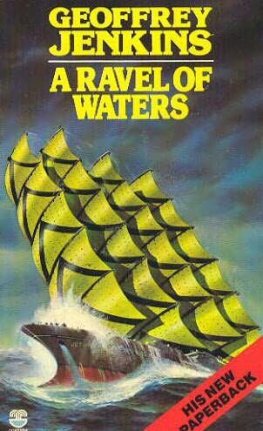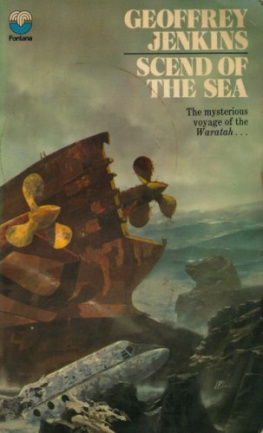Geoffrey Jenkins - A Twist of Sand
Here you can read online Geoffrey Jenkins - A Twist of Sand full text of the book (entire story) in english for free. Download pdf and epub, get meaning, cover and reviews about this ebook. genre: History. Description of the work, (preface) as well as reviews are available. Best literature library LitArk.com created for fans of good reading and offers a wide selection of genres:
Romance novel
Science fiction
Adventure
Detective
Science
History
Home and family
Prose
Art
Politics
Computer
Non-fiction
Religion
Business
Children
Humor
Choose a favorite category and find really read worthwhile books. Enjoy immersion in the world of imagination, feel the emotions of the characters or learn something new for yourself, make an fascinating discovery.

- Book:A Twist of Sand
- Author:
- Genre:
- Rating:4 / 5
- Favourites:Add to favourites
- Your mark:
- 80
- 1
- 2
- 3
- 4
- 5
A Twist of Sand: summary, description and annotation
We offer to read an annotation, description, summary or preface (depends on what the author of the book "A Twist of Sand" wrote himself). If you haven't found the necessary information about the book — write in the comments, we will try to find it.
A Twist of Sand — read online for free the complete book (whole text) full work
Below is the text of the book, divided by pages. System saving the place of the last page read, allows you to conveniently read the book "A Twist of Sand" online for free, without having to search again every time where you left off. Put a bookmark, and you can go to the page where you finished reading at any time.
Font size:
Interval:
Bookmark:
GEOFFREY JENKINS (1920 - 2001)
A TWIST OF SAND (1959)
The South West of Africa has the most dangerous and desolate coastal region in the world. It is also, potentially, the richest. It is known, with reason, as The Skeleton Coast.
Fate gave one key to this forbidden place to Lieutenant-Commander Peace, R.N. He had been briefed, in conditions of absolute secrecy, for a deadly game of hide-and-seek with a new U-boat so far in advance of its time that the German High Command themselves distrusted it. It was this mission which brought Peace to the Skeleton Coast for the first time and it was then that the coast got into his blood. But it was only after the war when this obsession had drawn Peace back to the Skeleton Coast, that the possession of the same precious piece of knowledge forced him to undertake a perilous expedition over the most hazardous route in the world.
Geoffrey Jenkins has used the fascinating and unique setting of the Skeleton Coast as a background to a story which combines all the tension and suspense of submarine warfare with an adventure story of such imagination and power as will hold the reader spellbound.
All the characters in this book are imaginary and have no reference to any person, living or dead
AUTHOR'S FOREWORD
It is a fact that the German U-boat High Command tested experimental U-boats in Cape waters in 1941. Captain Johann Linbach, master of the German freighter Hastedt, was reported by The Star, Johannesburg, on 6th September, 1957: "During 1941, when Germany was testing a new model of submarine engine, six U-boats so equipped were sent to Cape waters .... only one returned."
The phenomenon of the "double sun" was recorded by meteorologists of the Pretoria Weather Bureau at Swakopmund, South West Africa, on 11th December, 1957.
Adiabatic warming of winter winds is an authentic meteorological occurrence in South West Africa. The colouring of the sea by the autumn bloom on plankton is also vouched for. It occurs in conjunction with gymnodinium, a deadly poison.
I have taken a liberty with the actual date on which the Dunedin Star was lost.
Pretoria, 1959
I Skeleton Coast
Twenty-one and a half feet. I shivered.
The movement shook loose from the edge of my duffle-coat a bead of icy moisture which skidded down my cheek and splashed in a tiny bright spangle on the chart under the concentrated glare of the angled light. I shivered again, half in fear, half in discomfort. The fog was condensing everywhere, and I could feel its sharp tingle in my throat. Dawn in fog is the time for any skipper's fears; dawn in fog off the Skeleton Coast is the time of nightmares.
The drop of moisture made a north-westerly digression over the fold of the chart as Etosha rolled uneasily. Lying on it, the grey photostat page of the old log, with its neat, Victorian script, looked a little weary, despite its shiny rejuvenation at the magic wand of the camera which had plucked it from forgotten oblivion in a fusty London shipping office.
I slid the photostat of the ship's log under the 18-degree line of the chart as if, by placing it in the exact position where she had struck, I might gain some vital information from its meagre sentences.
"British steam vessel Clan Alpine. 13th January, 1890. Bound Tilbury to Cape Town. 5 a.m. Ship, drawing 2i feet, struck unknown object, thought to be a shoal, 18' 2" S, 11' 47" E. Position 326 degrees distant about 26 miles from Cape Frio. Doubtful. Making water in Number One hold but proceeding at reduced speed . . ." The one page of the Clan Alpine's log told all; it told enough; there was nothing later for my purposes.
Twenty-one and a half feet! Hell, that was little enough, and here I was with fully sixteen on Etosha's marks and in the same deadly shoal water. Three hundred and twenty-six degrees -- that would put the shoal about three to five miles offshore. If that was right -- I shook my head unconsciously -- and another droplet splashed down in the fug of the chart-room, warm by comparison with the bone-chilling air of the bridge, where only a canvas dodger stood between me and the naked elements.
The old Clan Alpine log by itself would never do. I'd snap Etosha's back on the same shoal before I knew where I was if I stuck to it alone. The other logs -- would they break open the Chinese puzzle? I reached for three other photostats lying on the top right-hand corner of the chart. The heading was uncovered. " Africa -- South West Coast" said the writing. " Bahia dos Tigres to Walvis Bay." Who, I wondered vaguely, gave Tiger Bay that sonorous and Miltonic name? Some old Portuguese navigator? Christ! I thought, I'm just the same as one of those old seamen feeling his way down the same unmapped, uncharted coast ot South West Africa south of Angola, the only difference being that I'm using an echo-sounder in this year of grace 1959 instead of a lead-line, as in the year of Our Lord 1486. And mighty thankful I am to have a magnificent modern trawler under me with powerful engines instead of a caravel, unhandy and ungainly, under sail. A sailing ship would be tossing with sails slatting; at least I was holding Etosha under the barest steerage way as I probed into the unknown.
I spread the three other photostats out fanwise on the chart below the old Clan Alpine's log. Pratt at the Admiralty had really done a good job with the old logs. It was purely for old time's sake in the Navy, I knew. that. I certainly had no right to them, under my peculiar circumstances.
"H.M.S. Alecto, 1889," was written in Pratt's copperplate. I grinned to myself. It brought back memories of his meticulous attention to detail at Gib. during the war. " H.M.S. Mutine, 1911 " said the second photostat log heading. " H.M.S. Swallow, 1879," the third was titled. I knew their contents by heart -- a five fathom shoal four miles off the coast, reported Alecto; a rock with breakers two and a half miles offshore, reported Mutine; eight fathoms, with breakers, three miles from the coast, reported Swallow. Swallow had added one bit of information. " sand and mud bottom." I grinned wryly. There was something to be said for using a lo-pound lead-line armed with a tallow bottom eighty years ago. It added one tiny little piece to the jigsaw.
I looked at the litter on the chart. By themselves, the inaccurate old logs were enough of a riddle, but the blasted German log threw the whole picture haywire. I wished now I had never dug around in the German archives in Winkhoek and never clapped eyes on or heard the name of the German warship Hyane. But I had, and here lay the salt-marked log just to prove that all my theories about the location of the shoal were wrong. I didn't have to consult it as it, too, lay on the chart. ..." Breakers during a moderate SSW gale and a high sea, in a position 282 degrees, distant 2 miles from high pointed hill." Two miles! I couldn't credit it. At that distance from the shore the Kaiser's old battle-wagon would have been a dead duck on the iron-hard sand of the shoal. And probably a rock or two through her armour-plating as well. The bearing, 282 degrees, was just about the craziest I had ever encountered.
I straightened up from the chart table. I was being mocked by the ghosts of ships which had long since gone to their graves. Their tall old-fashioned stacks and yardarmed masts seemed to cluster out of the fog round the modern, sharp lines of Etosha like a cerement ushering her to doom. All dead ships -- and a shoal of death right under me now.
I shivered again. The dawn made it more morbid still. I looked down at the untidy chart table and cursed them all heartily. I needed fresh air. I cursed the bright light over the chart also: if it had been my old submarine, it would have been red, and I could have gone up on to the bridge without being blind for ten minutes before my eyes accustomed themselves to the blackness aloft.
Next pageFont size:
Interval:
Bookmark:
Similar books «A Twist of Sand»
Look at similar books to A Twist of Sand. We have selected literature similar in name and meaning in the hope of providing readers with more options to find new, interesting, not yet read works.
Discussion, reviews of the book A Twist of Sand and just readers' own opinions. Leave your comments, write what you think about the work, its meaning or the main characters. Specify what exactly you liked and what you didn't like, and why you think so.






